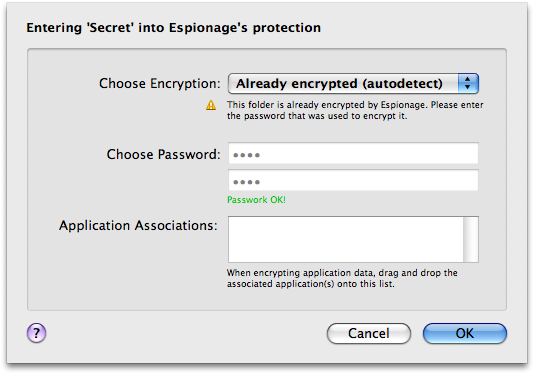After over a month in development, Espionage 2.1 is ready.
Espionage 2.1 is a significant update, and one of the major changes is full support for Snow Leopard. Espionage 2.1 itself can be thought of as a “Snow Leopard” kind-of update in that on the surface it may appear to be very similar to 2.0.8, but beneath its familiar exterior is a fully revamped interior.
This is a significant update that everyone using Espionage is strongly encouraged to update to, as it contains many significant bug fixes, including a fix for a rare kernel panic that could occur in previous versions of iSpy. Also, because 2.1 updates iSpy the iSpy installer will run again. You will not need to restart or logout though, unless after performing the update Espionage cannot establish communication with its helper.
One other note is that we’ve had the chance to finally investigate the Logitech Control Center issue, and it turns out that Espionage is compatible with it, but only with the latest version of LCC (as of this writing, 2.7). Espionage 2.1 will detect if you have an older version installed and will refuse to run until you update to the latest version. Click here for more information.
Here is the full list of significant changes:
- NEW: Snow Leopard Support
- NEW: Autodetection of encryption settings upon adding an already encrypted folder
- NEW: Xcode template to protect Xcode snapshots
- FIXED: Panic in iSpy that could happen in certain situations.
- FIXED: Crash that could happen after 1.x -> 2.x upgrade
- FIXED: Fixed a bug resulting in 1.x -> 2.x upgraded folders being listed as not encrypted
- FIXED: Issue where folder could get stuck with bad ACLs
- FIXED: Irrelevant error messages to console in relation to ACLs
- FIXED: Corrected iChat template
- FIXED: Minor bug associated with ExpanDrive integration while restoring a folder while it’s unlocked
- FIXED: Minor bug where dependencies for one association could be used for another in app templates
- FIXED: Minor UI glitch when updating Espionage’s helper
- CHANGED: Updated code signing certificate, you will be prompted to re-authorize Espionage to access keychain
- IMPROVED: Modified warning for detection of Logitech Control Center to suggest update to latest version if necessary
- IMPROVED: Updated all components of iSpy, now Snow Leopard compatible, fixed several memory leaks
- IMPROVED: Significantly improved documentation on backing up folders (including documentation on Time Machine and other tools)
- IMPROVED: When searching for a process, match only processes with same exact name, as opposed to names that contain it
- IMPROVED: Espionage now detects upon launch folders that weren’t properly locked and syncs up to the situation
- IMPROVED: Behavior on waiting for associations to quit when helper is stopped
- IMPROVED: Changed default backup interval to 1 hour
- IMPROVED: Protective ACLs are removed from folder while it’s disabled to allow folder sync with apps like ChronoSync
- IMPROVED: Improved wording of password cover
- IMPROVED: Improved a notification associated with disabling a folder
- IMPROVED: Added check to detect when multiple, conflicting disk images could already exist for a folder being added
- IMPROVED: Added check to detect when an already encrypted folder being added to Espionage was renamed
- IMPROVED: Updated BWToolkit to 1.2.2
Overview of Significant Changes
Auto-detection of encryption settings
In previous versions of Espionage, adding an already encrypted folder to Espionage (for example, a folder you retrieved from backups), you needed to know two pieces of information: how the folder was encrypted originally, and what password was used to encrypt it.
Now you only need to know only one piece of information, and that’s the password that was used to encrypt the folder. Espionage will automatically detect the folder’s encryption for you:

Snow Leopard support and updated iSpy
Espionage 2.1 is now ready to be used on Snow Leopard, so those of you who have pre-release versions of it installed can now use your favorite encryption tool on it! 🙂
iSpy has also been updated, it is now much more robust, and a few small memory leaks have been plugged. A small number of users experienced kernel panics with the previous version, this is now fixed in 2.1.
Improved backup documentation!
We received some emails saying that our backup documentation could use some work, and hopefully with 2.1 we’ve addressed your concerns. It now includes documentation on how to restore or backup using Espionage’s backups, Time Machine, or using a third-party software/service. Check it out!
Espionage 2.1.1 Release Notes
2.1.1 fixes a couple of rare and minor issues with 2.1:
- FIXED: Rare issue with trial error dialogue
- FIXED: Rare issue that could lead to a failure to encrypt a folder
- FIXED: Spelling of “Unlocking” (thanks Andreas)
Hi !
Is there any german localization (planned) for Espionage ?
Thanks ! Dirk
Yes it is, although no time line is set for that yet.
Hello. I upgraded to Snow leopard and now Espionage does not work like it used to. There is no way to lock it from the right click menu. Every time I open ANY finder window my locked folders all prompted me at once, even if where I am has nothing to do with the locked folders. I used to love Espionage! What happened?? I tried uninstalling and reinstalled downloading it from Toa. Still the same problems! Someone please help.
Hi Jacob, in Snow Leopard Apple has disabled all third-party contextual menu items, but what you can do is use Apple’s “Eject” contextual item instead. To do this you’ll need to open the folder first, and then right-click on its background. We’re going to provide alternative ways of locking soon.
Regarding the other problem you described, please contact us through our support page, that will help us best troubleshoot the problem you’re describing:
http://www.taoeffect.com/espionage/support/